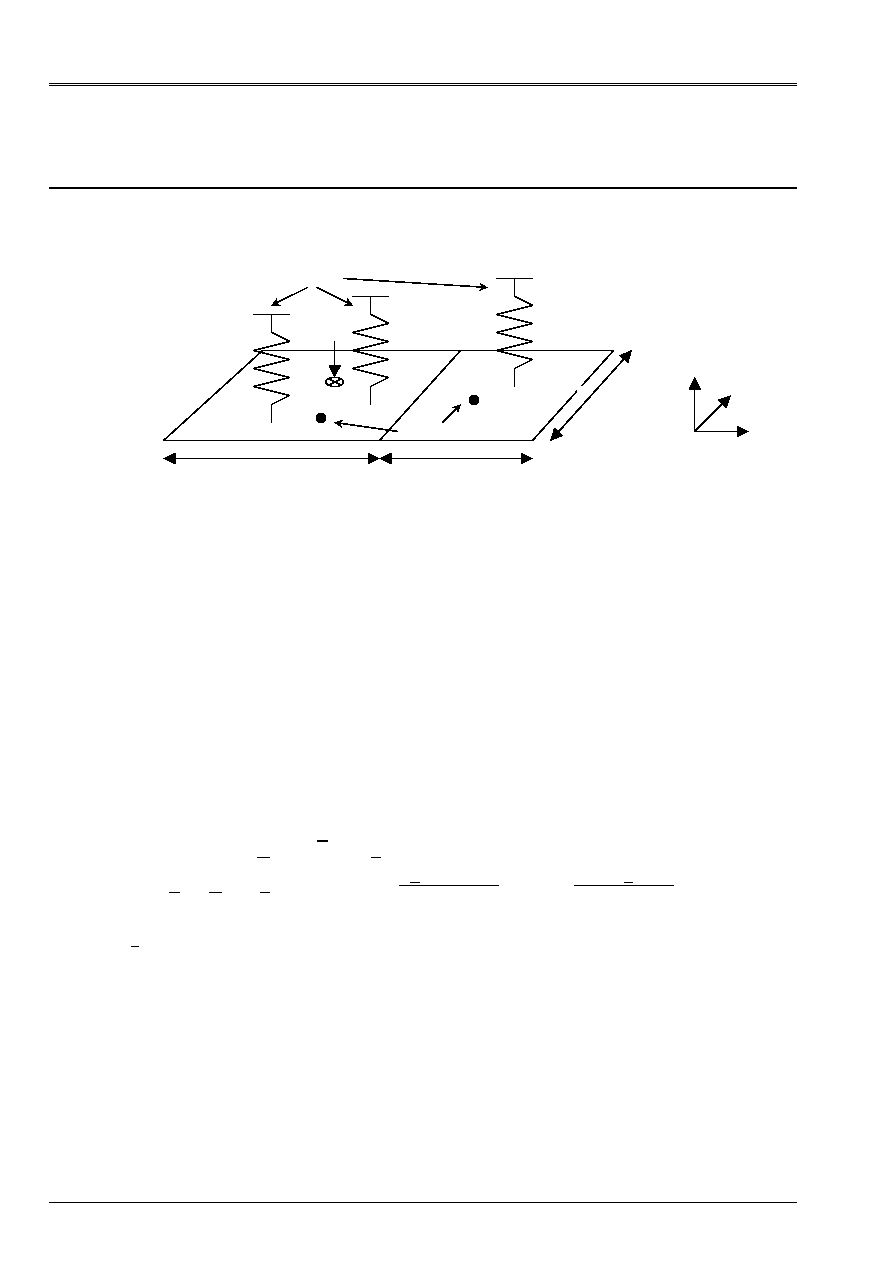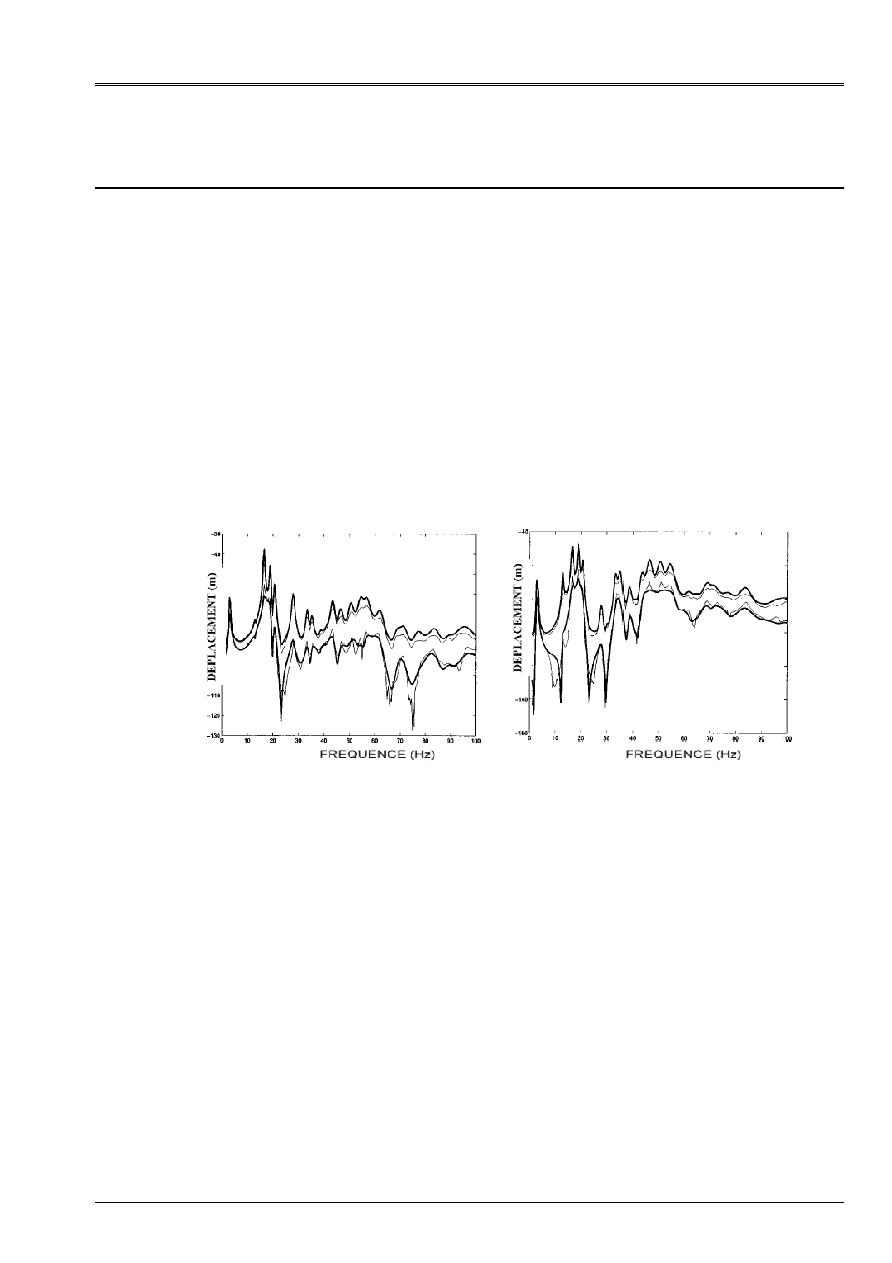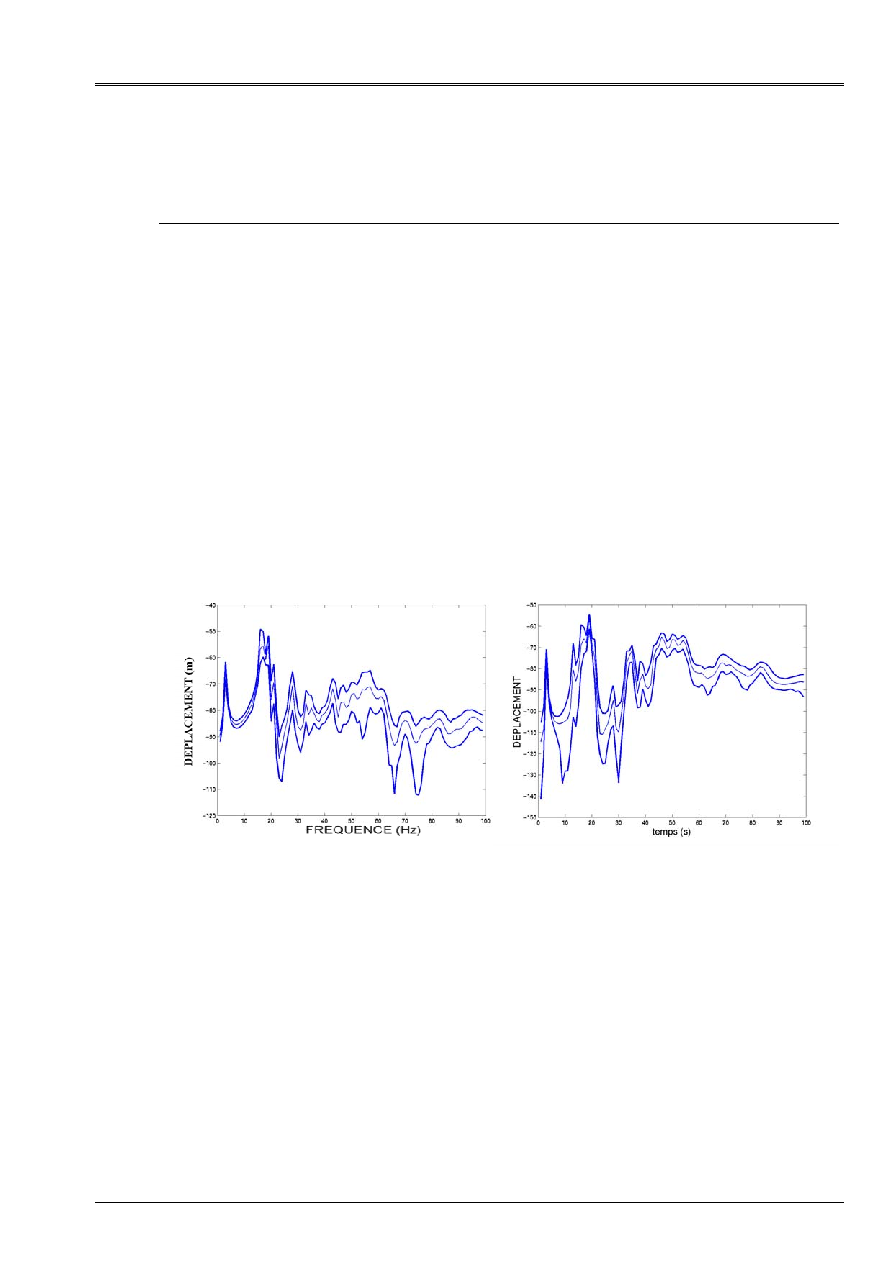
Code_Aster
®
Version
8.1
Titrate:
SHLS200 - Nonparametric probabilistic model in harmonic
Date:
04/05/06
Author (S):
S. CAMBIER, A. BATOU
Key
:
V2.06.200-A
Page:
1/6
Manual of validation
V2.06 booklet: Harmonic response of a linear system
HT-62/06/005/A
Organization (S):
EDF-R & D/AMA
Manual of Validation
V2.06 booklet: Harmonic response of a linear system
Document: V2.06.200
SHLS200 - Nonparametric probabilistic model:
Harmonic response of a under-structured plate
Summary:
This case-test treats taking into account of random uncertainties for the calculation of a harmonic answer by
under-structuring of the type Craig Bampton. We take again here an example of the literature made up of one
plate supported at its ends.
The functionality of operator GENE_MATR_ALEA consisting in is tested taking for entering concept one
concept macr_elem_dyna of a given substructure and to produce a random macr_elem_dyna (mass,
stiffness and damping). The concepts macr_elem_dyna random products then make it possible to calculate
for example the field of confidence of the harmonic response of the plate.

Code_Aster
®
Version
8.1
Titrate:
SHLS200 - Nonparametric probabilistic model in harmonic
Date:
04/05/06
Author (S):
S. CAMBIER, A. BATOU
Key
:
V2.06.200-A
Page:
2/6
Manual of validation
V2.06 booklet: Harmonic response of a linear system
HT-62/06/005/A
1
Problem of reference
1.1 Geometry
The model is a thin section thickness 0.4 10
- 3
m rectangular separate in two substructures
including/understanding each one a concentrated mass.
1.2
Material properties
The materials is homogeneous and isotropic.
Mass density: 7800 kg/m
3
,
Young modulus: 2.1 10
11
NR/m
2
Concentrated stiffness: 2.388 10
7
NR/m,
Coordinated stiffnesses concentrate: (0.28, 0.22), (0.54, 0.33) and (0.83, 0.44),
Mass concentrated: 3 kg for substructure 1 and 4 kg for substructure 2,
Coordinated masses concentrate: (0.4, 0.2) and (0.75, 0.35).
Damping
The matrix of damping [D] is defined as being a linear combination of the matrices
averages of mass [M] and stiffness [K]:
[D] =a [M] + B [K] with
min
max
min
max
min
max
2
2
+
=
+
=
B
has
and
,
where
=0.04,
min
=5.2
rad/S and
max
=212.8
rad/S.
1.3
Boundary conditions and loadings
The flexbeam is in simple support on its four edges.
Substructure 1 is subjected to an effort external with the item (0.24, 0.24) equal to 1N on the tape
of analysis [0, 2
.100] rad/S following direction Z and null on other DDLs and for the others
frequencies.
1.4 Conditions
initial
The dynamic system is initially at rest.
1
2
Specific masses
charge
0.6m
0.4m
0.5m
Springs
y
Z
X

Code_Aster
®
Version
8.1
Titrate:
SHLS200 - Nonparametric probabilistic model in harmonic
Date:
04/05/06
Author (S):
S. CAMBIER, A. BATOU
Key
:
V2.06.200-A
Page:
3/6
Manual of validation
V2.06 booklet: Harmonic response of a linear system
HT-62/06/005/A
2
Reference solution
2.1
Method of calculation used for the reference solution
The method used is the method published in particular in [bib1] (cf [§2.3]). Uncertainties
random of the dynamic system are modelized by using the probabilistic model said not
parametric of uncertainties due to Soize (cf [bib1]). Statistics on the harmonic answer of
linear dynamic system are obtained by the method of Monte Carlo. The procedure is identical
with that presented to [§ 3.3], but developed under Matlab.
In the standard commodity, 500 hard copies are carried out and the envelopes lower and higher of
these 500 hard copies are presented.
2.2
Results of reference
The ddls of observation correspond to direction DZ of the node of co-ordinates (0.39, 0.31) for
first substructure and of the node of co-ordinates (0.79, 0.24) for the second substructure.
The results of reference are given in the form of the graphs below drawn from [bib1].
Node (0.39, 0.31), DZ
Node (0.79, 0.24), DZ
Inter-quantiles fields (milked thin) of displacements to the ddls of observation
Results of reference
(the fatty features are approximations, not used here for the comparison)
2.3 Reference
bibliographical
[1]
C. SOIZE and H. CHEBLI: “Random Uncertainties Model in Dynamic Substructuring Using has
Nonparametric Probabilistic Model, ASCE Newspaper off Mechanics Engineering,
0733-9399 (2003) 129:4 (449).

Code_Aster
®
Version
8.1
Titrate:
SHLS200 - Nonparametric probabilistic model in harmonic
Date:
04/05/06
Author (S):
S. CAMBIER, A. BATOU
Key
:
V2.06.200-A
Page:
4/6
Manual of validation
V2.06 booklet: Harmonic response of a linear system
HT-62/06/005/A
3 Modeling
With
3.1
Characteristics of modeling
Modeling:
DKT
The average model with the finite elements of the plate consists of a regular rectangular mesh
whose pitch is constant and is worth 0.01m in directions X
1
and X
2
. Consequently, all elements
stop are identical and each one is an element plates with 4 nodes.
Modeling:
DIS_T
The concentrated masses and the concentrated stiffness are modelized by elements DIST_T.
3.2
Characteristics of the mesh
The average model finite elements comprises 14849 active degrees of freedom, including 8840 for
substructure, 1, 5860 for substructure 2 and 149 for the interface.
A number of degrees of freedom: 8840+5860+149
A number of finite elements: 6000 QUA4 et3 DIS_T
3.3
Method of calculation
Small-scale model
As for the reference, we take for each substructure 20 modes in order to have good
convergence of the calculated response with respect to the number of modes.
Achievements of the random matrices of the nonparametric probabilistic model by under
structure
For each under structures, reduced matrices of masses, stiffnesses and dissipation of
model means are replaced by achievements of the random matrices of mass, stiffnesses and
of dissipation according to the nonparametric probabilistic model. For that, we use the generator
random matrices GENE_MATR_ALEA which generates a concept macr_elem_dyna from one
macr_elem_dyna average.
One can thus allot to each substructure a level of uncertainty by fixing the parameters of
dispersion for each substructure. We fixed them at 0.1 for each matrix of
masses, of stiffnesses and generalized damping and for each substructure.
Resolution of the probabilistic linear dynamic system.
Operator DYNA_LINE_HARM is used to build the harmonic response of the plate for
each random realization of the matrices of mass, stiffness and dissipation.
The frequential interval of the study is B= [0,100] Hz, with a pitch of 0.5
Hz.
Construction of the statistical estimates.
After each call to DYNA_LINE_HARM, we have a realization of the fields of
displacement. With each hard copy (iteration of Monte Carlo) we build the statistical estimates
with the aid only of operator CALC_FONCTION and key words WRAPS, POWER and
COMB.

Code_Aster
®
Version
8.1
Titrate:
SHLS200 - Nonparametric probabilistic model in harmonic
Date:
04/05/06
Author (S):
S. CAMBIER, A. BATOU
Key
:
V2.06.200-A
Page:
5/6
Manual of validation
V2.06 booklet: Harmonic response of a linear system
HT-62/06/005/A
3.4 Functionalities
tested
Controls
GENE_MATR_ALEA
The functionality tested of GENE_MATR_ALEA is the possibility of producing a concept of the type
macr_elem_dyna starting from another concept of the macr_elem_dyna type.
3.5
Sizes tested and results
The initial validity of the case test was established by graphic comparison with the bibliographical reference
data in [§2.2]. The answers are calculated into 1 point for each substructure; these points have
for co-ordinates: (0.39, 0.31) and (0.79, 0.24).
As for the reference, the envelopes lower and higher of 500 hard copies are calculated. For
each frequency, the inter-quantile field corresponding corresponds, for example with a level of
confidence
from 0.95, with a probability of 0.994 for the maximum value and 0.006 for the value
minimal.
The results obtained with Code_Aster are represented on the curves below:
Node (0.39, 0.31), DZ
Node (0.79, 0.24), DZ
Fatty features: inter-quantiles fields of displacements to the ddls of observation
(thin features: averages)
Code_Aster results

Code_Aster
®
Version
8.1
Titrate:
SHLS200 - Nonparametric probabilistic model in harmonic
Date:
04/05/06
Author (S):
S. CAMBIER, A. BATOU
Key
:
V2.06.200-A
Page:
6/6
Manual of validation
V2.06 booklet: Harmonic response of a linear system
HT-62/06/005/A
One tests the following values in nonregression (cf comments):
Statistics on the values in displacement with 30Hz with the ddl of observation of the first substructure
Parameters References Aster %
Difference
Higher envelope
6.7338296870618D-05
6.7338296870618D-05
0
Lower envelope
5.1116761251425D-05
5.1116761251425D-05
0
Estimate of the average
6.0802671417375D-05
6.0802671417375D-05
0
Estimate of the moment
of command 2
3.7457833680156D-09 3.7457833680156D-09
0
Statistics on the values in displacement with 30Hz with the ddl of observation of the second substructure
Parameters References Aster %
Difference
Higher envelope
4.3459496115461D-04
4.3459496115461D-04
0
Lower envelope
2.8511128677169D-04
2.8511128677169D-04
0
Estimate of the average
3.5186242151806D-04
3.5186242151806D-04
0
Estimate of the moment
of command 2
1.2765909447885D-07 1.2765909447885D-07
0
3.6 Comments
The various statistical estimates are not converged here. Only 3 simulations of
Monte Carlo were made drastiquement to reduce time CPU of the case test. Convergences
having been validated on the study supplements (after convergence, the statistical estimates calculated with
to start from Code_Aster correspond to the results given by the cf graphs, standard commodity), case
test is satisfied with nonthe regression.
4
Summary of the results
The results obtained are completely in conformity with those of the bibliographical reference [§2.2] obtained
entirely in Matlab.





